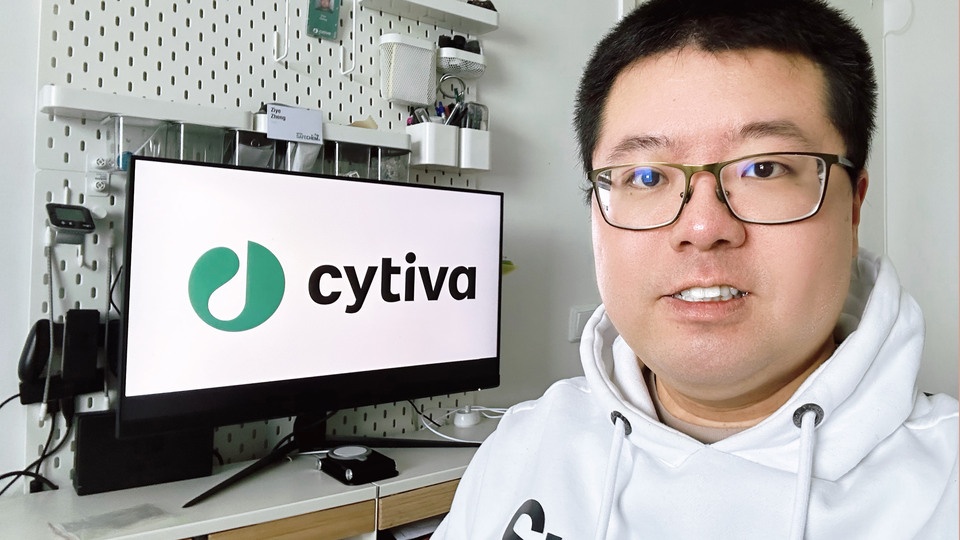
– I have developed machine learning models for the prediction of mutagenicity, carcinogenicity, reproductive toxicity, skin sensitization, eye irritation and corrosion, as well as endocrine disruptions, Ziye Zheng says.
Ziye Zheng is developing a chemical hazard prediction tool tailored to Cytiva’s needs
Postdoc Ziye Zheng, working at the Mistra SafeChem partner Cytiva, is developing a toxicity prediction tool based on machine learning models.
– This is a chemical hazard prediction tool that is tailored to our needs. The collaboration within Mistra SafeChem is extremely valuable to us, says Ismet Dorange, Cytiva.
Ziye Zheng works with the in silico team of Mistra SafeChem which has the goal to develop a toolbox of computational models for chemical toxicity prediction. He is focusing on toxicity models based on traditional machine learning algorithms.
In 2021, Cytiva wanted to hire a postdoc and develop an in silico toolbox for their chemical alternative selection and Ziye found it to be the perfect opportunity to combine his research with real industrial challenges. He applied and work with Mistra SafeChem since then.
Computational toxicity models are excellent tools
How does your research contribute to the Mistra SafeChem vision of a safe, sustainable and green chemical industry?
– If industries want to be greener in the chemical aspect, the first thing they need to know is whether the chemicals they plan to produce or use are toxic or not. However, many chemicals, especially novel ones, lack experimental toxicity data, and toxicity testing is both expensive and time-consuming. Computational toxicity models can provide reliable toxicity predictions for many chemicals in a very short time, and they are very easy to use. They are excellent tools for industries to identify potentially toxic chemicals and narrow down their chemical alternatives list, Ziye says.
What are the results so far?
– I have developed machine learning models for the prediction of mutagenicity, carcinogenicity, reproductive toxicity, skin sensitization, eye irritation and corrosion, as well as endocrine disruptions. The models have good prediction reliability. Also, I have developed these models into computer software with an easy-to-understand graphical user interface.
The tool is accurate, user-friendly, quick, and comprehensive
We asked Ismet Dorange, research and development manager at Cytiva, how Ziye’s work is contributing to Cytiva’s risk assessment.
– Ziye has developed a chemical hazard prediction tool that is tailored to Cytiva’s needs. It is accurate (as much as such a model can be), user-friendly, quick, and comprehensive. And as such is critical in all research and development projects, especially in the early phase.
How do you use the results?
– The toxic character of the chemicals used when developing a new product is now an integral part of our project review process. The chemists involved in the project are using the prediction tool to prioritize the chemicals used. The reviewers will also use the tool to make sure the best chemical in terms of the toxic profile is used.
How does the collaboration within Mistra SafeChem contribute to Cytiva?
– It is extremely valuable to us. There are tools available out there but none has all the desired characteristics. To develop a successful chemical hazard prediction tool, one must have expertise in chemistry, toxicology and “computer science”. With Mistra SafeChem, we found it all under one roof. But the impact of the collaboration does not stop there, as we are also benefiting from hearing from the other work packages and conferences organized by Mistra SafeChem, says Ismet Dorange.
Closer collaboration needed between in silico and experimental toxicologists
We asked Ziye Zheng what further research is needed in this field.
– One of the most important is that more high-quality experimental toxicology data are needed for the development of high-quality models. This requires closer collaboration between in silico and experimental toxicologists, he says.
Also, to have the models better used, collaborations are needed between modellers and other people in the green chemistry field, such as life cycle assessment experts and industrial partners.
– Mistra SafeChem provides a good platform for these collaborations.
Read more about the work of Ziye Zheng in the Mistra SafeChem annual report for 2022 Pdf, 8.1 MB, opens in new window..
Pdf, 8.1 MB, opens in new window..
-
2024-04-03 | newsFour more years – Mistra SafeChem gets go-ahead for second phase
-
2024-03-28 | newsThe 2023 Mistra SafeChem annual report focuses on more than just one year
-
2024-03-21 | newsSETAC conference on LCA will be held in Gothenburg
-
2024-02-27 | newsMistra SafeChem researchers keynote speakers at large conference on SSbD
-
2024-02-16 | newsThe Mistra SafeChem cosmetics study specially invited to EU workshop on SSbD

